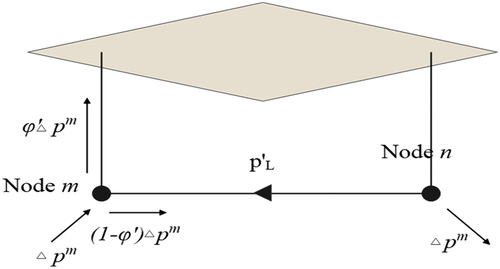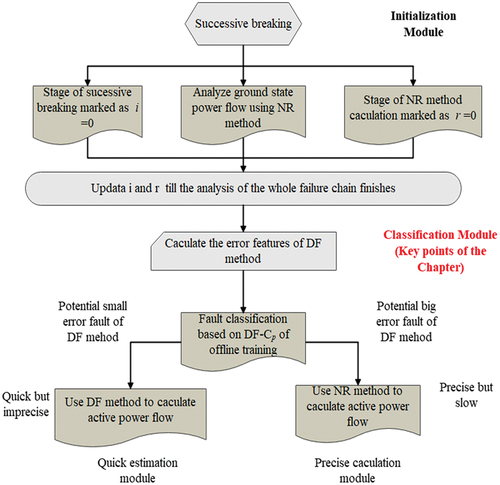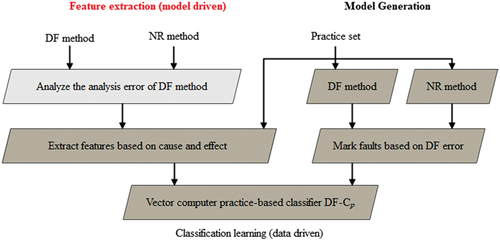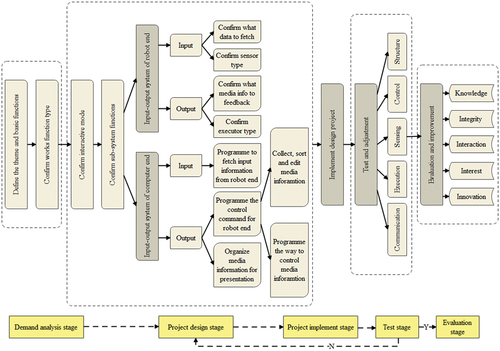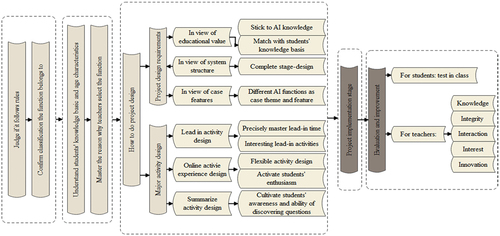 ?Mathematical formulae have been encoded as MathML and are displayed in this HTML version using MathJax in order to improve their display. Uncheck the box to turn MathJax off. This feature requires Javascript. Click on a formula to zoom.
?Mathematical formulae have been encoded as MathML and are displayed in this HTML version using MathJax in order to improve their display. Uncheck the box to turn MathJax off. This feature requires Javascript. Click on a formula to zoom.ABSTRACT
To improve the teaching effect of the Chinese language and literature majors, this paper combines artificial intelligence technology and performance to build a teaching system for the Chinese language and literature majors. Based on the existing coordination algorithms, this paper proposes a classifier-based fast calculation method for successive breaking of active power flow, which provides high-quality active power information for the static safety check and control of successive breaking at a small computational cost. Moreover, this paper improves the operation effect of the teaching system, increases the calculation speed, and adopts the NR method for algorithm-sensitive faults to ensure the reliability of the power flow results. The proposed teaching system was tested in a simulated teaching environment to evaluate its effectiveness. The testing results showed that the system significantly improved student performance, engagement, and satisfaction. However, some challenges and limitations were also encountered during the testing process, such as the need for sufficient computing power and the difficulty in accommodating individual learning styles. The findings of this paper suggest that the proposed teaching system has the potential to enhance the learning outcomes of Chinese language and literature students. However, further testing and optimization are needed to address the challenges and limitations encountered in the testing process.
Introduction
There are some practical contents in the existing language and literature curriculum system, but the characteristics of practicality in the whole curriculum system have not been fully proposed. At this time, it is necessary for teachers to continue to excavate practical Chinese and literature resources, based on the cultivation of practical application ability, to realize the practical transformation of language and literature courses, thereby guiding the actual language and culture of colleges and universities to enter a practical state (Almoshmosh et al. Citation2019). For students majoring in the Chinese language, the construction of a practical curriculum system can be mainly attributed to the ability to perceive language and culture, appreciate language and culture, and apply language and culture. Future jobs will require students’ ability in these three aspects. Based on such professional considerations, the direction of practical application ability training has been determined (Bakhov et al. Citation2021).
The language and literature research experiment activities are carried out through language and literature reviews, appreciation of language and literature works, and language and literature creations. Students are encouraged to learn language knowledge independently, choose specific language and literature topics, and conduct reviews, appreciation, and creation. This makes the practical experience of language and literature develop in an ideal direction (Boer, Hanke, and He Citation2018).
For example, holding ancient novels book report conferences, ancient literature thematic course essay competitions, performing classical literature works, etc., are important measures to enhance the interaction between students and actual texts. More importantly, it can make the original static language and culture curriculum develop and progress dynamically (Charoensukmongkol Citation2020).
By simulating social work roles, creating corresponding language and cultural application situations, putting forward requirements for the ability of actual role roles, focusing on the ability of speech expression, the ability of official document writing, the ability of interpersonal communication, etc., so as to properly handle the actual situation The relationship between job demands and ability requirements is also one of the important paths for practical courses to be put into practice. It is believed that with the promotion of the above measures, the model for the cultivation of language and literature practical application ability will develop in a more perfect direction. At this time, college teachers can reshape the classroom system in accordance with such demands, and then they can be more targeted, and then guide actual colleges and universities. Language and literature education and teaching show practical characteristics (Desai et al. Citation2018).
In the process of realizing the practical transformation of the curriculum system, it is also necessary to adjust the actual teaching methods, adhere to the basic principles of student-oriented, pay attention to effective interaction, ensure that the actual exchange and communication mechanism can be constructed, and then enter a more ideal The practical teaching pattern of language and literature is indispensable for guiding the actual play of curriculum benefits (Karadag Citation2020).
In the process of realizing the construction of the practical teaching system for language and literature majors, in addition to realizing the practical transformation of the curriculum, it is also necessary to control the process of centralized practical training to ensure that it becomes a practical second platform to guide practical learning. The environment is developing in a more optimized direction (Koç and Kafa Citation2019).
In the student internship report, students are required to fill in the demands of language and literature during the internship according to the actual situation and reflect on their own shortcomings and deficiencies in this area. On this basis, a more targeted career development plan is formulated and attached to the internship In order to ensure that schools can more comprehensively understand the current requirements of enterprises for students’ language and cultural literacy, and then enhance the interaction between schools and real enterprises, to ensure that the actual language and literature education cognition develops in a more practical direction. It should be noted that it is necessary to guide students to fill in truthfully, which will become an important opportunity for graduation quality assessment and teaching reflection (Kumi-Yeboah Citation2018).
In the process of internship, students should know how to actively participate in various practical activities of language and literature, especially when some enterprises or units carry out cultural construction work, intern students should familiarize themselves with the corresponding platform as soon as possible, understand the relationship between corporate culture and culture. The integration point between language and culture majors and realize the innovation of language and culture practice activities, and then express themselves on this platform, reflect on themselves, and realize the continuous exercise of their own language and literature literacy. In the process of language and literature education and teaching in colleges and universities, if the method of indoctrination is emphasized blindly, teachers are the leading and students are the assistants. Over time, college students will lose their enthusiasm for language and literature learning, and then make the actual language and literature education into inefficiency state (Kwon Citation2019). Obviously, this is what we do not want to see, and we need to take effective measures to guide the development of teaching in the direction of practice. On the one hand, it is necessary to take measures to realize the mining of practical teaching resources of language and literature, carry out various practical activities in the classroom, and guide the efficient development of education and teaching behavior; Literary applications carry out multiple interactions, thereby constructing a good language and literature practice environment. This is very valuable for guiding the actual development of language and literature education and teaching in colleges and universities toward the ideal direction (Lappalainen, Nylund, and Rosvall Citation2019).
Chinese language and literature contain extremely rich connotations and profound philosophies. Through the continuous accumulation of Chinese language and literature and the independent appreciation of American literary masterpieces, students can greatly improve their aesthetic level and the macro and complex emotional cognition of the world. For example, reading articles imagining the future can stimulate students’ lofty aspirations, develop students’ phenomenal thinking, and strengthen their motivation (Loinaz Citation2018); reading articles expressing will can establish a proud and healthy attitude of “the poor cannot be moved, the mighty cannot be subdued.” Personality: reading landscape travel notes can enable students to “travel around the world” by reading, know the world’s affairs without going out, and guide students to yearn for beauty; reading worldly articles can enable students to gradually understand the wisdom of dealing with the world, and make close friends with superb emotional intelligence, so that people around you can enjoy the spring breeze. Unlike other concrete majors, Chinese language and literature can see their own progress. The Chinese language and literature major sublimates students’ thinking level in a subtle way and precipitates a personal “poetry in the belly.” The charm of writing style from China” (Lucchetti et al. Citation2018).
The mastery of Chinese language ability can enable students to be more eloquent and eloquent, to think more broadly than others on the same issue, and to be able to organize and express their own views in refined language. Necessary elements, in actual work, it is important to be down-to-earth and work hard, but at the same time, you should also communicate more with colleagues and leaders to understand the direction and needs of the enterprise, rather than use your professionalism to deviate from the development of the enterprise according to your own intuition. On the trajectory, wasting time and doing useless work, a person who only has professional ability but does not understand innovation, cannot think, and is not good at speaking will eventually be eliminated by society. In the influence of literary works, Chinese language and literature lovers have absorbed countless As long as the wisdom of celebrities is reasonably transformed into their own knowledge, they can easily win a world in the social wave (Luz et al. Citation2019).
Chinese language and literature is like a vast ocean, storing precious cultural relics passed down from generation to generation. Teachers start from themselves and attach great importance to Chinese language and culture education. For the development of the new era, respect the dominant position of students, infiltrate with interesting Chinese language content, and stimulate students’ motivation to learn Chinese language. Culture, with the characteristics of ethnic minority students, to carry out cultural activities, it is not suitable to read incessantly, which will cause students’ rebellious psychology, and can appropriately implement the cultural inheritance of the Chinese language according to local customs (Marsh et al. Citation2020).
In addition to cultivating students’ literary quality, Chinese language and literature also plays an active guiding role in the spiritual field. Teachers should use the meaning and philosophy of Chinese language to improve students’ moral quality and allow students to regulate their own words and deeds. Chinese language and literature and other disciplines Teaching should be carried out simultaneously and should not rely too heavily on basic subjects and ignore the practicality of the Chinese language. Teachers should give full play to the advantages of the Chinese language and use democratic humanistic care to influence students with bad habits (Nordin and Norman Citation2018). For example: some students They don’t focus on learning, they always fight and fight. Teachers can guide students to contact more hero biographies, so that they can turn their brute force into helping the weak, establish a sense of role model for them, and cultivate students’ sentiments. Another example: some students face Full of confusion about life, always entangled and not knowing how to choose, teachers can let students choose the correct life path based on the lessons learned in Chinese language (Richards Citation2019).
This paper proposes a novel teaching system for Chinese language and literature that combines artificial intelligence technology and performance to enhance teaching quality. The system is based on AI-driven technology that improves data processing efficiency and accuracy. The factor method adopted in this paper simplifies the power flow calculation, and the SSA algorithm used for successive breaking represents an innovative approach to power flow analysis. These techniques significantly reduce the computational cost and enhance the teaching system’s real-time performance. Additionally, the proposed teaching system provides an engaging and personalized learning experience by adapting to individual student needs and preferences. This feature represents a significant innovation in the field of Chinese language and literature education, as it allows for a more tailored and effective approach to learning.
To achieve this goal, the paper introduces a novel approach to data processing that utilizes AI-driven technology to improve efficiency and accuracy. Additionally, the paper presents the factor method for simplified power flow calculation and the SSA algorithm for successive breaking. These techniques significantly reduce computational costs and improve the real-time performance of the teaching system.
Moreover, the proposed teaching system offers a personalized learning experience by adapting to individual student needs and preferences. The system’s ability to process data efficiently and in real-time, coupled with its personalized approach to learning, represents a significant advancement in the field of Chinese language and literature education.
Overall, the paper highlights the significant innovations presented in the proposed teaching system and their potential to enhance the learning outcomes of Chinese language and literature students. However, challenges and limitations, such as the need for sufficient computing power and accommodating different learning styles, must also be considered.
Analysis of Intelligent Features of Chinese Language Teaching Data
Fast Calculation of Active Power Coordinated by Two Algorithms
In order to improve the data processing effect of the teaching system, this paper uses artificial intelligence-driven technology to improve the data processing effect of the intelligent teaching system.
The factor method adopts the simplified assumption of the DC power flow method, and the calculation principle is shown in . In SSA, the successive occurrence and simultaneous occurrence of line breaking faults have the same power flow result. For the convenience of derivation, the successive breaking only discussed in this chapter involves only one branch in each breaking stage.
In a system with nodes and branches, it is assumed that the branch l connected with nodes m and n has a breaking fault, and the active power on l before breaking is
.
According to the assumption of the power flow method, breaking the branch l is equivalent to injecting the same amount of active power
in the reverse direction to the nodes m and n. Therefore, the active power variation on branch l is
, and the total active power variation of the other branches connected to node m is
. When
satisfies formula (1), the active power on branch l is reduced to 0, and
is equivalent to the breaking fault of branch l:
In order to conveniently rewrite formula (1) into matrix form, vectors and
are constructed based on elements
and
, respectively. C is the node-branch correlation matrix of
order. Taking the elements in the lth column as an example, the elements in the mth and nth rows are 1 and −1 respectively, and the other elements are all 0. Combining the matrix
, the matrix expression of formula (1) can be obtained:
According to the DC power flow method, the voltage phase angle change vectors and
satisfy:
Substituting formula (2) into formula (3), we get:
If the -order branch susceptance square matrix
is known, according to the branch power flow expression of the DC power flow method, the change value
of the branch active power flow after the line is disconnected can be solved:
Substituting formula (4) into formula (5), we get:
In the formula, is the
-order branch disconnection distribution factor (LODF) matrix, and
.
Combined with the stage characteristics of successive breaking, the formula (6) is extended to the active power flow of the i-th stage branch of successive breaking based on the DF method.
The DF method simulates the actual breaking of the line with the change of the active power injection at the node, and simplifies the nonlinear power flow problem into the calculation of the linear equation. The calculation amount is extremely small, but the error is usually large.
In the above system, the active injection power of node m based on the NR method can be expressed as:
If node m and n are connected to branch l, the transformer ratio of branch l is . According to the calculation results of v and
in formula (8), the active power on branch l can be solved:
Formula (9) is rewritten into matrix form, that is, the calculation result of the active power flow of the branch in the i-th stage of successive breaking by the New method:
If the ill-conditioned power flow is not considered, when the NR method is used to solve the problem, the state variable in the previous switching stage is the initial solution. After solving
according to formula (8),
is then solved by formula (9).
In order to effectively coordinate the DF method with a small amount of calculation and the NR method with high accuracy, this section constructs a fast calculation framework based on the fault classifier for the calculation problem of successive interruption of active power flow, as shown in . The framework contains four modules:
(1) Initialization module
The initialization module gives the breaking stage i and the latest NR method calculation stage r according to the fault information of successive breaking. In the ground state (fault does not occur), i=r = 0. Considering that optimizing the start-up value can improve the accuracy of the approximation algorithm, this chapter adopts the NR method to reduce the calculation error of the entire fault chain for the ground-state case of successive interruptions.
(2) Classification module
According to the fault information provided by the initialization module, the classification module calculates the error characteristics of the DF method, and classifies the faults based on accordingly.
(3) Fast estimation module
According to the classification results of , the DF method is used to quickly estimate the active power results of the algorithm-insensitive faults. While the fast estimation module uses the DF method to improve the computational efficiency of the framework, the computational error of its output results is controlled within an acceptable range by
, which ensures the reliability of the results.
(4) Precise calculation module
The accurate calculation module uses the NR method to accurately calculate the active power flow of the algorithm-sensitive fault identified by , and uses it as the starting value of the next breaking stage. The framework further improves the computational accuracy by removing the computational error of such faults, and the computational load of the NR method required by a small number of algorithm-sensitive faults will not cause too much computational burden to the framework.
As described in the introduction, model-driven and data-driven approaches have the advantages of robustness and efficiency, respectively. Specifically, in order to make the classifier output the selection result of the causal algorithm adaptively, this chapter extracts the input features of the classifier through causal analysis to reduce the generalization error. Moreover, this paper uses statistical methods to learn the correlation between features (inputs) and patterns (outputs) to improve classification accuracy, as shown in .
Analysis of Error Extraction Features Based on Factor Method
In order to ensure the generalization ability of the classifier, this section extracts causal features according to the parsing error of the DF method. For the convenience of description, this paper refers to the expression of Taylor expansion in classic works:
In the formula, . Since the DF method calculates the linear change
of the active power flow according to the formula (7), it is approximately equal to the first-order term
in the formula (11). The analytical error
of the DF method (the difference between the DF method and the NR method) can be calculated as follows:
The errors are divided according to successive breaking stages, and contains the nonlinear error
of this stage and the accumulated error
of the previous stage.
The error reflects the influence of Taylor expansion nonlinear terms (second-order and above terms). Only the Taylor expansion constant term
and the first-order term
are retained in the power flow results of the DF method at the current breaking stage. Since
does not consider the error of the constant term, that is, the exact
is taken as the starting value (
in formula (12)), so
is calculated as follows:
The error reflects the influence of the error in the starting value
, and the influence
of the nonlinear term in the Taylor expansion is not considered, and is calculated as follows:
In addition to describing the cumulative error in this stage, is also the analytical error of the DF method in the (i-1) stage, which can be solved by iterating the analytical errors of the DF method at each stage. Therefore, it is necessary to find the corresponding breaking stage when the two start values are the same, and record this stage as stage (r + 1). Then, the r-th stage (r<i) is the most recent calculation stage using the NR method. The Taylor series expansion expression of
with respect to the equilibrium point
of the r-th stage is as follows:
Based on the difference between (formula (7)) and
(formula (15)),
is obtained:
Combining formulas (13) and (16), the analytical error of the DF method includes
and
.
The nonlinear error feature at this stage extracted according to includes two parts: the feature
extracted based on the second-order term and the feature
extracted based on the voltage phase angle change.
(1) Second-order term features
In order to avoid the over-fitting of the classifier due to the over-complexity of the features, it is necessary to simplify the features, and solve the F-norm and 1-norm corresponding to and
respectively to achieve data dimensionality reduction, and refer to Appendix A for the calculation of the two norms. The second-order term feature
is the product of two norms:
(2) Phase angle variation features
Although second-order terms play a key role in most nonlinear analyses, ignoring third-order and above terms may make invalid in some cases, which in turn leads to lower accuracy of the classifier in some cases. Therefore, in this section, the phase angle variation features are extracted from the perspective of all nonlinear terms of the Taylor expansion, so that they complement each other with the second-order term features in the nonlinear error features at this stage. In addition to formula (13), the nonlinear error at this stage can also be described as:
After linearizing formula (19), we can get:
Therefore, based on the strong correlation between and
, the evaluation characteristics of nonlinear error in this stage can be proposed. The DF method directly provides
rather than g information
. Considering the amount of calculation, the strong correlation between
and
in formula (4) can be used again, and the 1-norm of
is taken as the phase angle change feature
:
In order to realize the fast estimation of the Hessian matrix, the numerical perturbation method is still used, and is approximated as
.The linear relationship between
and
is shown in formula (4), and this term is equivalent to
. When the influence of
is not considered, according to the definition of the LODF matrix,
and
,
can be approximately evaluated using the F-norm of the matrix
and used as the feature
.
Design of Teaching System for Chinese Language and Literature Major Driven by Artificial Intelligence Technology
The interesting interactive teaching mode combines the characteristics of the robot online interactive system, and depicts the composition structure of the robot hardware end and the computer program end from the perspective of input and output. Moreover, it analyzes its specific application types from the two perspectives of work function and human-computer interaction. In addition, the interesting interactive teaching mode is mainly used in the field of robot education. The specific content of the interesting interactive teaching mode is shown in .
This model takes the AI open platform as the carrier, and takes the teaching design steps as the clue to gradually advance, so that teachers can design the teaching content of the artificial intelligence module in the process. From the selection of appropriate functions to the design of the main teaching activities to the final implementation and evaluation, there are reference models and supports. The model is shown in .
TEAM education almost contains most of the knowledge and practical content of science and engineering. Under the penetration of artistic concepts, the five fields complement each other and promote mutual development. It is scientifically rigorous, technically practical, engineering is practical, mathematical logic is strong, and art is full of humanity. Its comprehensive utilization can provide strong support for the STEAM concept. As shown in , artificial intelligence popularization education should focus on students as the center, emphasize students’ initiative in learning, and adopt project-based teaching methods to enable students to learn independently in cooperation. At the same time, it is necessary to avoid teacher-centered knowledge instillation, and build an artificial intelligence project-based teaching model that integrates teaching objectives, teaching activities, and teaching tools. As shown in , the artificial intelligence teaching model for Chinese language and literature majors is constructed, as shown in . The implementation of the AI curriculum is guaranteed at each stage of analysis, design, development, implementation and evaluation.
Figure 6. Teaching system of Chinese language and literature major. (a) Flow chart of artificial intelligence teaching model integrating STEAM concept, (b) Artificial intelligence project-based teaching mode.
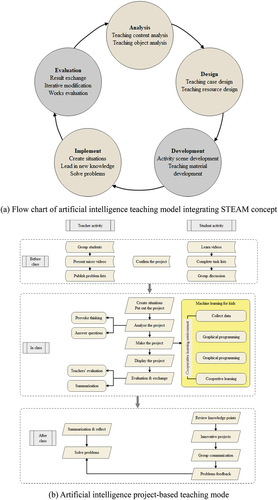
On this basis, the teaching effect of the artificial intelligence technology-driven Chinese language and literature teaching system proposed in this paper is verified, and the teaching effect is verified through the simulation teaching mode, and the teaching evaluation results are obtained as shown in .
Figure 7. Evaluation of the teaching effect of the teaching system of the Chinese language and literature major driven by artificial intelligence technology.
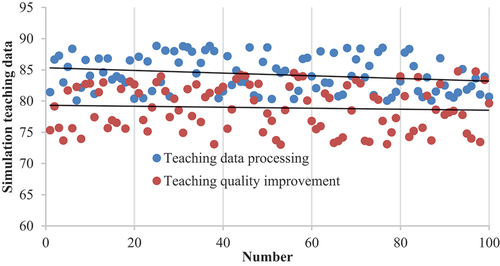
Through the above research, we can see that the teaching system of the Chinese language and literature major driven by artificial intelligence technology proposed in this paper can effectively improve the teaching effect of Chinese language and literature major.
The proposed teaching system for Chinese language and literature combines artificial intelligence technology and performance to enhance the teaching quality. The system’s key innovation is the use of AI-driven technology to improve data processing efficiency and accuracy. To achieve this goal, the paper introduces the factor method for simplified power flow calculation, which reduces computational costs while maintaining the accuracy of the power flow results. Additionally, the SSA algorithm used for successive breaking represents an innovative approach to power flow analysis that provides high-quality active power information for static safety checks and control. The proposed teaching system also offers a personalized learning experience by adapting to individual student needs and preferences. The system’s ability to process data efficiently and in real-time, coupled with its personalized approach to learning, represents a significant advancement in the field of Chinese language and literature education.
Despite the potential of the proposed teaching system, challenges and limitations exist, such as the need for sufficient computing power and the need to accommodate different learning styles. Nonetheless, the significant innovations presented in this paper have the potential to revolutionize Chinese language and literature education, and enhance the learning outcomes of students in this field.
Conclusion
Language and literature courses are related to the cultivation of literary and language literacy of corresponding majors. Therefore, more effective teaching strategies must be adopted. However, from the actual research, the practical teaching of language and literature in colleges and universities has not entered a systematic state, which will affect the effective development of language and literature education and teaching in colleges and universities. In this regard, effective measures must be taken to improve it. As we all know, the advantages of various professional education in colleges and universities lie in practicality and application, which is very important to exert its effectiveness in cultivating professional talents in various fields. This paper combines artificial intelligence technology and performance to build a teaching system for Chinese language and literature majors. The research on simulation teaching shows that the teaching system of the Chinese language and literature major driven by artificial intelligence technology proposed in this paper can effectively improve the teaching effect of Chinese language and literature major.
Disclosure statement
No potential conflict of interest was reported by the author.
References
- Almoshmosh, N., H. J. Bahloul, A. Barkil-Oteo, G. Hassan, and L. J. Kirmayer. 2019. Mental health of resettled Syrian refugees: A practical cross-cultural guide for practitioners. The Journal of Mental Health Training, Education and Practice 15 (1):20–1201. doi:10.1108/JMHTEP-03-2019-0013.
- Bakhov, I., T. Byrkovych, O. Makarchuk, A. Varyvonchyk, L. Turchak, and R. Soichuk. 2021. Enhancing cross-cultural competence of students under conditions of limited social communication. Ad Alta: Journal of Interdisciplinary Research 11 (1):51–56.
- Boer, D., K. Hanke, and J. He. 2018. On detecting systematic measurement error in cross-cultural research: A review and critical reflection on equivalence and invariance tests. Journal of Cross-Cultural Psychology 49 (5):713–34. doi:10.1177/0022022117749042.
- Charoensukmongkol, P. 2020. The efficacy of cultural intelligence for adaptive selling behaviors in cross-cultural selling: The moderating effect of trait mindfulness. Journal of Global Marketing 33 (3):141–57. doi:10.1080/08911762.2019.1654586.
- Desai, S. V., S. S. Jabeen, W. K. Abdul, and S. A. Rao. 2018. Teaching cross-cultural management: A flipped classroom approach using films. The International Journal of Management Education 16 (3):405–31. doi:10.1016/j.ijme.2018.07.001.
- Karadag, E. 2020. The effect of educational leadership on students’ achievement: A cross-cultural meta-analysis research on studies between 2008 and 2018. Asia Pacific Education Review 21 (1):49–64. doi:10.1007/s12564-019-09612-1.
- Koç, V., and G. Kafa. 2019. Cross-cultural research on psychotherapy: The need for a change. Journal of Cross-Cultural Psychology 50 (1):100–15. doi:10.1177/0022022118806577.
- Kumi-Yeboah, A. 2018. Designing a cross-cultural collaborative online learning framework for online instructors. Online Learning 22 (4):181–201. doi:10.24059/olj.v22i4.1520.
- Kwon, J. 2019. Third culture kids: Growing up with mobility and cross-cultural transitions. Diaspora, Indigenous, and Minority Education 13 (2):113–22. doi:10.1080/15595692.2018.1490718.
- Lappalainen, S., M. Nylund, and P. Å. Rosvall. 2019. Imagining societies through discourses on educational equality: A cross-cultural analysis of Finnish and Swedish upper secondary curricula from 1970 to the 2010s. European Educational Research Journal 18 (3):335–54. doi:10.1177/1474904118814140.
- Loinaz, E. S. 2018. Towards a cross-cultural conceptual framework for researching social and emotional education. IAFOR Journal of Education 6 (3):111–27. doi:10.22492/ije.6.3.07.
- Lucchetti, G., R. F. Damiano, L. F. DiLalla, A. L. G. Lucchetti, I. L. D. Moutinho, O. Silva Ezequiel, and J. Kevin Dorsey. 2018. Cross-cultural differences in mental health, quality of life, empathy, and burnout between US and Brazilian medical students. Academic Psychiatry 42 (1):62–67. doi:10.1007/s40596-017-0777-2.
- Luz, C., R. Cordovil, L. P. Rodrigues, Z. Gao, J. D. Goodway, R. S. Sacko, D. R. Nesbitt, R. C. Ferkel, L. K. True, and D. F. Stodden. 2019. Motor competence and health-related fitness in children: A cross-cultural comparison between Portugal and the United States. Journal of Sport and Health Science 8 (2):130–36. doi:10.1016/j.jshs.2019.01.005.
- Marsh, H. W., P. D. Parker, J. Guo, R. Pekrun, and G. Basarkod. 2020. Psychological comparison processes and self–concept in relation to five distinct frame–of–reference effects: Pan–Human cross–cultural generalizability over 68 countries. European Journal of Personality 34 (2):180–202. doi:10.1002/per.2232.
- Nordin, N., and H. Norman. 2018. Cross-culture learning via massive open online courses for higher education. Jurnal Pendidikan Malaysia [Malaysian Journal of Education 43 (1):35–39. doi:10.17576/JPEN-2018-43.01-05.
- Richards, C. 2019. Later life learning from experience: The cross-cultural importance of “life reviews” in seniors’ lifelong education and learning. Zeitschrift für Weiterbildungsforschung 42 (1):5–22. doi:10.1007/s40955-018-0123-7.

